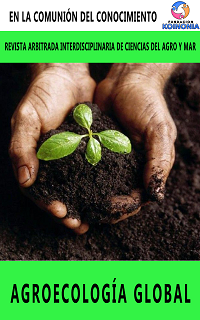Etnoagronomía: Una alternativa para el desarrollo rural en México
DOI:
https://doi.org/10.35381/a.g.v4i7.1879Palabras clave:
Estrategias en investigación, producción agrícola, saberes, campesinos, sustento. (Tesauro UNESCO).Resumen
The crisis of the rural sector in productive and environmental matters; they can unleash other alternative development processes to the hegemonic ones. Ethnoagronomy, as an emerging approach when resuming the synthesis of peasant knowledge present in traditional agriculture, establishes guiding principles for efficient management of the use and management of natural resources. The objective of this work is to describe the importance of ethnoagronomy, to establish sustainable production strategies within a framework of human resource training in agronomic institutions. It is based on an ethnographic study of a hermeneutical nature. It is concluded that it is necessary to incorporate curricular lines and study plans, at the middle and higher education level, that contain guiding principles that prioritize and recognize the feelings and thoughts of the subjects who are considered the depositories of the transformation. productive and social in rural areas.
Descargas
Citas
Ayala Garay, A., Schwentessius Rindermann, R. y Gómez Cruz, M. (2019). El sector agropecuario de México en el TLCAN: lecciones y nuevo escenario. [The agricultural sector of Mexico in NAFTA: lessons and a new scenario]. https://n9.cl/w0846
Banco Mundial. (2008). Informe sobre el Desarrollo Mundial 2008 Agricultura para el desarrollo. [World Development Report 2008 Agriculture for development]. https://n9.cl/o4i0q.
Camín, E. (2022). La explotación de las y los trabajadores rurales: realidades indecentes. [The exploitation of rural workers: indecent realities]. ALAI. https://n9.cl/wnorv
CEDRSSA. (2020). La agricultura y su relación con la pobreza en México. [Agriculture and its relationship with poverty in Mexico]. Palacio Legislativo de San Lázaro. Ciudad de México. 28. https://n9.cl/t781e
Cervantes-Herrera, J., Cruz-León,A., Salas Gonzales, J., Peréz-Fernández, Y., y Torres Carral, G. (2016). Saberes y tecnología tradicionales en la pequeña agricultura familiar campesina en México. [Traditional knowledge and technology in small family farming in Mexico]. En Revista de Geografía Agrícola. No 57. pp: 129-142. https://n9.cl/yikxk
Chauvet, M y Lazos, E. (2014). El maíz transgénico en Sinaloa: ¿tecnología inapropiada, obsoleta o de vanguardia? Implicaciones socioeconómicas de la posible siembra comercial. [Transgenic corn in Sinaloa: inappropriate, obsolete or cutting-edge technology? Socioeconomic implications of potential commercial planting]. Sociológica, 29 (82). México. https://n9.cl/6owbe
CONEVAL. (2019). Diez años de medición de pobreza multidimensional en México: avances y desafíos en política social. [Ten years of multidimensional poverty measurement in Mexico: advances and challenges in social policy]. Medición de la pobreza serie 2008-2018. México. https://n9.cl/ym035
Cruz-León, A., Cervantes-Herrera, J., Damián-Huato, M.A., Ramírez-Valverde, B. & Chávez-Segura, P.G., (2015). Etnoagronomía, tecnología agrícola tradicional y desarrollo rural. [Ethnoagronomy, traditional agricultural technology and rural development]. https://www.redalyc.org/articulo.oa?id=75749286006.
Cruz-León, A. (2008). De la tecnología agrícola tradicional a la etnoagronomia: hacia la construcción de una propuesta. [From traditional agricultural technology to ethnoagronomy: towards the construction of a proposal]. En: La dimensión cultural en procesos de desarrollo rural regional: casos del campo mexicano. Tim Trench, Artemio Cruz León (coordinadores). Universidad Autónoma Chapingo. Pp: 113-127
Escobar, A. (2012). La invención del desarrollo. [The invention of development]. Editorial Universidad el Cauca, Popayán, Colombia.
FAO. (2009). Situación alimentaria en América Latina y el Caribe. Observatorio del hambre. [Food situation in Latin America and the Caribbean. hunger observatory]. Oficina Regional para América Latina y el Caribe. Boletín 7 de junio.
Gurdián-Fernández, A. (2007). El Paradigma Cualitativo en la Investigación Socio-Educativa. [The Qualitative Paradigm in Socio-Educational Research]. Colección: Investigación y Desarrollo Educativo Regional (IDER). San José, Costa Rica.265p
Hernández, X. (1985). Agricultura tradicional y desarrollo. En: Xolocotzia. Tomo I. [Traditional agriculture and development. In: Xolocotzia. Volume I The Qualitative Paradigm in Socio-Educational Research]. Revista de Geografía Agrícola de la Universidad Autónoma Chapingo. Primera edición. México. pp: 419-424
Illich, I. (1985). La sociedad descolarizada. [The deschooled society]. México. https://n9.cl/98h9o
INEGI. (2020). Censo de Población y Vivienda. Aguascalientes, México. [Census of population and housing. Aguascalientes, Mexico].
Mariaca, M. (1997). ¿Qué es la agricultura? (bajo una perspectiva xolocotziana). [What is agriculture? (under a xolocotsian perspective)]. 1ª edición. UACh-UAEM. México.
Martínez, M. (2019). México depende de granos de EU casi en 100%: GCMA. El Economista. [ Mexico depends on grains from the US almost 100%: GCMA. The Economist]. https://n9.cl/tj62a
(OIT). (2022). Déficits de trabajo decente entre los trabajadores rurales. Principales conclusiones y recomendaciones para los sindicatos. Suiza. [ Decent work deficits among rural workers. Main conclusions and recommendations for trade unions]. https://n9.cl/k2a78
Rubio, B. (2010). El neoliberalismo y la crisis económica agropecuaria. [Neoliberalism and the agricultural economic crisis]. Conferencia magistral presentada en el seminario: La sociología rural en el mundo de hoy. Celebrado los días 25 al 29 de enero, en el Departamento de Sociología Rural de la Universidad Autónoma Chapingo. Texcoco. México.
Publicado
Cómo citar
Número
Sección
Licencia
CC BY-NC-SA : Esta licencia permite a los reutilizadores distribuir, remezclar, adaptar y construir sobre el material en cualquier medio o formato solo con fines no comerciales, y solo siempre y cuando se dé la atribución al creador. Si remezcla, adapta o construye sobre el material, debe licenciar el material modificado bajo términos idénticos.
OAI-PMH URL: https://fundacionkoinonia.com.ve/ojs/index.php/agroecologiaglobal/oai





.png)


